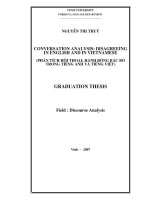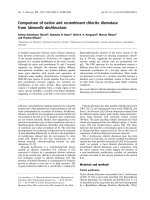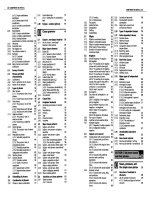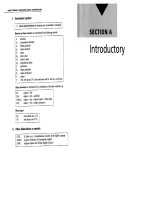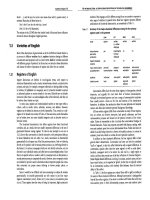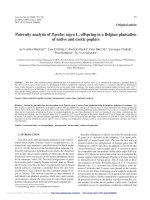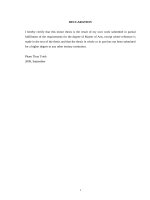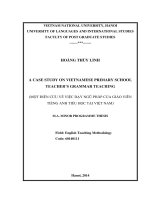Self-efficacy of native and non-native English speaker teachers = Hiệu lực bản thân của giáo viên tiếng Anh bản ngữ và không bản ngữ.PDF
Bạn đang xem bản rút gọn của tài liệu. Xem và tải ngay bản đầy đủ của tài liệu tại đây (909.3 KB, 70 trang )
iii
TABLE OF CONTENTS
Acknowledgements i
Abstract ii
List of tables, figures, and abbreviations v
PART A: INTRODUCTION 1
1. Statement of the research problem and rationale for the study 1
2. Aims of the study 2
3. Scope of the study 3
4. Methodology 3
5. Significance of the study 4
6. Organisation of the thesis: 4
PART B: DEVELOPMENT 6
CHAPTER 1: LITERATURE REVIEW 6
1.1. Review of literature related to Self-efficacy and Teacher Self-efficacy theories 6
1.1.1. Definition, roles, sources, and types of self-efficacy 6
1.1.2. Self-efficacy and Social cognitive theory 11
1.1.3. Teacher self-efficacy 13
1.2. Demographic factors that affect teacher self-efficacy 16
1.2.1. Teacher self-efficacy and teaching experience 16
1.2.2. Teacher self-efficacy and gender 17
1.3. Dimensions of teacher self-efficacy 18
1.4. Non-native English speaker teacher & Teacher self-efficacy 20
1.4.1. Non-native vs. Native English speaker teacher 20
1.4.2. Non-native English speaker teacher self-efficacy 21
1.5. The context of teaching at the Faculty of English Language Teacher Training,
University of Languages and International Studies (FELTE, ULIS) 23
1.6. How does this study fit into other research? 24
1.7. Summary 27
CHAPTER 2: METHODOLOGY 28
2.0. Research questions 28
2.1. Sampling and Participants 28
iv
2.1.1. Sampling procedures 28
2.1.2 Participants 29
2.2. Instrumentation 29
2.3. Procedures of data collection 33
2.4. Procedures of data analysis 34
2.5. Summary 35
CHAPTER 3: RESULTS AND DISCUSSIONS 36
3.1. Results of construct validation of the TEBS-Self 36
3.2. Sample characteristics 39
3.3 Participant profile 42
3.3. Research question 1: What is the self-efficacy of NNESTs? 43
3.4. Research question 2: What is the self-efficacy of NESTs? 46
3.5. Research question 3: What is the relationship between the self-efficacy of these two
parties in terms of gender and teaching experience? 48
CHAPTER 4: SUGGESTIONS AND RECOMMENDATIONS 54
4.1. Teacher development at FELTE, ULIS, VNUH 54
4.2. Teacher training program design at FELTE, ULIS, VNUH 55
PART C: CONCLUSION 56
List of references 58
APPENDIX 1 I
APPENDIX 2 II
v
LIST OF TABLES, FIGURES, AND ABBREVIATIONS
List of Tables
Table 1 - Reliability of Karimvand’s (2011) instrument 32
Table 2 - Cronbach's alpha Coefficients for the TEBS-S 32
Table 3 - TEBS-Self factor analysis results – 4 extracted components 37
Table 4 - TEBS-Self factor analysis results – Factor loadings 38
Table 5 - Participants' profile 42
Table 6 - NNESTs’ general efficacy beliefs (N=34) 44
Table 7 - Dimensions of TEBS-S 45
Table 8 - Statistics of the four sub-scales for NNESTs 45
Table 9 - NESTs’ general efficacy beliefs (N=6) 47
Table 10 - Statistics of the four sub-scales for NESTs 48
Table 11 - Statistics of the four sub-scales for NESTs and NNESTs 49
Table 12 - Independent samples t-test of the four sub-scales for NESTs and NNESTs 50
Table 13 - Gender aspect of the four dimensions of teacher self-efficacy 51
Table 14 - Experience aspect of the four dimensions of teacher self-efficacy 52
vi
List of Figures
Figure 1 - Bandura’s (1997) Triadic Reciprocal Causation Model 12
Figure 2 - Sample gender 39
Figure 3 - Teaching experience of the sample teachers 40
Figure 4 - Nationalities of the sample teachers 41
vii
Abbreviation
Native English Speaker Teacher
NEST
Non-Native English Speaker Teacher
NNEST
English as a Second Language
ESL
English as a Foreign Language
EFL
English Language Teachers Training
ELTT
Teaching English to Speakers of Other Languages
TESOL
Faculty of English Language Teacher Education
FELTE
University of Languages and International Studies
ULIS
Vietnam National University, Hanoi
VNUH
1
PART A: INTRODUCTION
his opening part illuminates the research problem and rationale for the study, together
with the aims, objectives, and the scope of the research. Primarily, in this part, the
research questions are identified to act as clear guidelines for the whole study.
1. Statement of the research problem and rationale for the study
As English becomes a global language for communication and business and the
teaching of English becomes a fast growth industry, an increasing number of English
language teachers who are non-native English speakers can be seen in English as a Second
Language (ESL) as well as in English as a Foreign Language (EFL) contexts around the
world. This raises so much interest in issues related to non-native English speaker teachers
(NNEST) in the field of teaching English to speakers of other languages (TESOL) that a
proliferation of papers, theses, dissertations, and publications has been dedicated to the
topic. Specifically, the issues of NNESTs have been examined from chiefly three different
areas of interest, which are the self-perceptions of NNESTs (e.g. Amin, 1997; Medgyes,
1983, 1994; Reves & Medgyes, 1994), the credibility of NNESTs (e.g. Amin, 1997, 1999;
Braine, 1999; Thomas, 1999), and the meaning of the label NNES educator and other
parties’ perceptions of NNES educators (e.g., Hansen, 2004; Inbar, 2001; J. Liu, 1999,
2004) (Kamhi-Stein, 2004).
Self-efficacy, on the other hand, has been a fresh and recent research issue in the
field of psychology and education (Bandura, 1995; Llurda, 2005; Graddol, 2007; Liu,
2009, Karimvand, 2011). Self-efficacy, as defined by Bandura (1995), is a person’s beliefs
in his or her ability to succeed in a particular situation. More precisely, it is “the belief in
one’s capabilities to organize and execute the courses of action required to manage
prospective situations” (Bandura, 1995, p.2). The concept of self-efficacy is different from
self-perception, which is an individual’s knowledge of their own “attitudes, emotions, and
other internal states” through inference from observations of their own behaviour and/ or
the circumstances in which this behaviour occurs (Bem, 1972, p. 2). The nature of self-
efficacy is more cognitive and more concerned with expectancy beliefs about an
T
2
individual's perceived capability to perform a certain task in a very specific domain
(Bandura, 1997, cited in Mercer, 2008). In other words, self-efficacy is “a context-specific
assessment of competence to perform a specific task, a judgement of one's capabilities to
execute specific behaviours in specific situations” (Pajares and Miller, 1994, p. 194). Self-
efficacy can have an impact on everything from psychological states to behaviour to
motivation, and thus, has become an important topic among psychologists and educators.
Research on the self-perceptions of native English speaker teachers (NESTs) has
received its fair share of attention (Braine, 1999; Kamhi-Stein, 2004; Llurda, 2005).
However, little has been done on the self-efficacy of NNESTs, which is the belief in their
own capabilities to succeed in their teaching career which can impact their psychological
states, behaviour, and motivation, etc. and in turn their students’ learning outcomes and
achievement.
In reality, at the Faculty of English Language Teacher Education, University of
Languages and International Studies (FELTE, ULIS) in Vietnam, the teaching of English is
in fact provided by a faculty comprising mainly native speakers of Vietnamese. What is
more, FELTE – previously part of the English Department – under University of
Languages and International Studies, Vietnam National University, Hanoi (ULIS, VNUH),
is one of the leading and avant-garde English teaching institutions in Vietnam, with –
among many others – the main aim of providing quality teachers of English for Vietnam.
On this ground, the researcher was motivated to carry out the research entitled “Self-
Efficacy of Native and Non-Native English Speaker Teachers”, which aims to
investigate the self-efficacy of NNESTs and to compare it with their NEST counterpart at
FELTE, ULIS, to see what factors affect their teaching and the effectiveness of their work.
2. Aims of the study
This research aims to investigate the self-efficacy beliefs of NNESTs and to compare
it with the self-efficacy beliefs of their NEST counterpart, and from the findings, to
propose some context-specific suggestions for the betterment of professional development
for NNESTs at ULIS-VNUH in particular and in Vietnam in general.
3. Scope of the study
3
Within the scope of an MA thesis, the research will not cover every aspect of self-
efficacy, nor with all categories of teachers at ULIS, VNUH. The study focuses on teacher
self-efficacy, among some other types of self-efficacy beliefs (Self-efficacy, 2011). In
particular, the study focuses on the self-efficacy of NNESTs and NESTs at FELTE,
ULIS, VNUH. It specifically targets self-efficacy in the educational context.
4. Methodology
i. Research questions:
1) What are the self-efficacy of NNESTs at FELTE?
2) What are the self-efficacy of NESTs at FELTE?
3) What is the relationship between the self-efficacy of these two parties in terms
of gender and teaching experience?
ii. Participants:
34 non-native English speaker teachers working in the EFL English language
teachers training (ELTT) program at VNUH and 6 native English speaker teachers
involved with ELTT program at VNUH and several other ELTT universities and colleges
in Vietnam were involved in the study.
iii. Instrumentation:
The methodology of this research is mainly quantitative. The study employs the
Teacher Efficacy Beliefs Scale – Self developed by Dellinger et al. (2008) to probe the
self-efficacy beliefs of both native English speaker teachers and non-native English
speaker teachers, and to analyse the correlation between the self-efficacy of these two
parties.
iv. Data analysis
The collected data were categorised and quantitatively analysed. Data from
questionnaires were statistically analysed to find answers to the research questions 1, 2, 3.
4
5. Significance of the study
On the basis of the statistical analyses of data, the self-efficacy of NNESTs and
NESTs will emerge, and thus be compared to existing literature. Then suggestions for
better professional development and eventually even better teaching quality at ULIS,
VNUH are proposed.
6. Organisation of the thesis:
This paper is divided into three main parts:
Part A is the INTRODUCTION. In this part, the rationales of the study, the aims,
research questions, the scope of the study, methods of the study and also its design are
presented.
Part B is the DEVELOPMENT which includes 4 chapters.
Chapter 1, Literature Review, deals with a theoretical background about the
definitions of the self-efficacy and its characteristics; “teachers’ self-efficacy”, and the
“non-native English speaker teachers”, together with an overview of the teaching context
at Faculty of English Language Teacher Education, University of Languages and
International Studies (FELTE, ULIS). At the same time, a review of related studies
discloses the research gap; thus, justifies the aims and objectives of the whole study.
Chapter 2, Research Methodology, describes the situation where the study was
conducted and the informants involved in the study. It includes the teachers of English,
both NSETs and NNSETs. The data collection instruments, procedures of data collection
and data analysis are also presented in this chapter.
Chapter 3, Results and Discussion, presents and discusses the findings on self-
efficacy of NESTs and NNESTs and a comparison of the two parties as well as the extent
that self-efficacy contributes to the work achievement of the two parties.
Chapter 4, Implications and Recommendations, presents some pedagogical
implications of the study and suggestions for even better professional development for
teachers at FELTE and eventually, even better teaching.
5
Part C is the CONCLUSION which summarizes the main points of the study,
limitations and suggests for further research.
REFERENCES and APPENDICES are presented in the last pages of the study.
6
PART B: DEVELOPMENT
CHAPTER 1: LITERATURE REVIEW
his first chapter sheds light on the literature pertinent to the present study, i.e. the
theoretical background and the review of studies relevant to the topic of research.
Initially, the theoretical background will be elucidated with an explanation of key concepts,
namely “self-efficacy”, “teachers’ self-efficacy”, and the “non-native English speaker
teachers”, together with a thematically organised review of relevant studies. Then, an
overview of the teaching context at Faculty of English Language Teacher Education
(FELTE), University of Languages and International Studies (ULIS), Vietnam National
University, Hanoi (VNUH) is presented. Finally, a statement of the place and importance
of the study in relation to current literature will justify the aims and objectives of the whole
research.
1.1. Review of literature related to Self-efficacy and Teacher Self-efficacy theories
The following part provides definition of the key concepts, which contribute to the
theoretical foundation of the study, and reviews relevant literature which lays out the
conceptualisation of the concept. Information is organised thematically.
1.1.1. Definition, roles, sources, and types of self-efficacy
Definition of self-efficacy
Self-efficacy, first coined by Albert Bandura (1977) in his social cognitive theory, is
a concept in the field of psychology which refers to a person’s beliefs in his or her own
ability to succeed in a particular situation. It is “the belief in one’s capabilities to organize
and execute the courses of action required to manage prospective situations” (Bandura,
1995, p.2). Pajares and Miller (1994) later provided a definition which highlights the
cognitive and context specific nature of self-efficacy, which is “a context-specific
assessment of competence to perform a specific task, a judgement of one's capabilities to
T
7
execute specific behaviours in specific situations” (p. 194). Pajares (2002), basing on
Bandura (1986), also defines self-efficacy beliefs as “people's judgments of their
capabilities to organize and execute courses of action required to attain designated types of
performances.” In other words, self-efficacy is a “future-oriented belief” about the level of
competence a person expects he or she will display in a given situation.
In the TESOL field, self-efficacy has often been confused, and sometimes referred to
inconsistently or even inaccurately, with other related terms such as “self-esteem” and
“self-concept”. In fact, all the three terms, “self-efficacy”, “self-esteem” and “self-
concept”, are under one umbrella known as “self-constructs” – beliefs about oneself which
are thought to affect behaviour and attitudes (Mercer, 2008). Self-constructs, such as self-
confidence, self-concept, self-efficacy, and self-esteem, have appeared in a wide array of
research areas in foreign language teaching such as works on affect, autonomy, identity,
individual differences, and motivation (e.g. Dörnyei 2005; Williams et al. 2004; Yang
1999; Yashima et al. 2004, cited in Mercer, 2008). In her journal article, Mercer (2008)
made a clear distinction among the three key self-constructs, i.e. self-esteem, self-concept,
and self-efficacy.
Citing the work of Valentine & DuBois (2005, p. 55), Mercer explained that all of
the three above concepts share “a common emphasis on an individual's beliefs in his or her
attributes and abilities as a person”; however, they are different in terms of (1) degree of
specificity with which they are measured, and (2) the relative importance of the cognitive
and evaluative elements. Firstly, self-esteem is seen as a more global construct, which
focuses on an individual’s overall evaluation of his/her worth or value as a person, and thus
considered as the broadest and most evaluative of the three constructs. In this aspect, “self-
esteem” and “self-worth” are often used interchangeably (Harter, 1999, p. 5, cited in
Mercer, 2008). In contrast, self-efficacy is more cognitive in nature and more concerned
with expectancy beliefs in one's perceived capability to perform a certain task in a very
specific domain (Bandura, 1997) such as managing a classroom or motivating students.
Self-concept, on the other hand, contains both cognitive and affective elements, and is
considered to be less context-dependent than self-efficacy. It is concerned with an
8
individual's self-perceptions in a wider domain (for example, teaching English as a foreign
language) than is the case for self-efficacy (Mercer, 2008).
Self-efficacy should also be distinguished from “self-perception”, which is an
individual’s knowledge of their own “attitudes, emotions, and other internal states”
through inference from observations of their own behaviour and/ or the circumstances in
which this behaviour occurs (Bem, 1972, p. 2). Meanwhile, as elucidated above, self-
efficacy is “more cognitive in nature and more concerned with expectancy beliefs in an
individual's perceived capability to perform a certain task in a very specific domain”
(Bandura, 1997, cited in Mercer, 2008).
Overall, self-efficacy is consistently defined as a person’s belief, assessment, or
judgement of their own capabilities to design and carry out context-specific sequences of
actions to perform a specific task or to succeed in a particular situation (Bandura, 1977,
1986, 1995; Pajares and Miller, 1994; Pajares, 2002). The concept should be distinguished
from other related concepts such as “self-esteem”, “self-concept”, and “self-perception”.
For the purpose of this research, self-efficacy, sense of self-efficacy, or self-efficacy belief,
used interchangeably, will adopt the above definition.
The Role of Self-Efficacy in human functioning
In their lives, humans can set goals, identify desirable changes & attainment;
however, there is a big difference between identifying goals, desirable changes, and
attainment to realizing those goals, carry out changes, and accomplish tasks. Bandura and
others suggest that an individual’s sense of self-efficacy can greatly contribute to how the
person approaches goals, tasks, and challenges (Cherry, 2011). Self-efficacy beliefs can
influence thought patterns and emotions that in turn affects the amount of effort people
expend in pursuit of goals, their persistence in the face of hardship, rebound from
obstructions, and the amount of control over events that affect their lives (Bandura, 1986,
1993, 1996, 1997, cited in Tschannen-Moran, Woolfolk Hoy, & Hoy, 1994). Generally,
people with a strong sense of self-efficacy: view challenging problems as tasks to be
mastered; develop deeper interest in the activities in which they participate; form a
stronger sense of commitment to their interests and activities; recover quickly from
9
setbacks and disappointments. Meanwhile, people with a weak sense of self-efficacy:
avoid challenging tasks; believe that difficult tasks and situations are beyond their
capabilities; focus on personal failings and negative outcomes; quickly lose confidence in
personal abilities (Bandura, 1994).
Bandura (1997) proposed that self-efficacy beliefs are “powerful predictors of
behaviour”. This proposition is supported by his observation: “People regulate their level
and distribution of effort in accordance with the effects they expect their actions to have.
As a result, their behaviour is better predicted from their beliefs than from the actual
consequences of their actions” (1986, p. 129, cited in Henson, 2001) as well as by other
research literature (Henson, 2001).
Sources of Self-efficacy
Self-efficacy beliefs can develop from four main sources. According to Bandura,
the four principle sources of information which influence self-efficacy are enactive or
mastery experiences, vicarious experiences, verbal persuasion, and physiological and
emotional states. In other words, they are “performance attainments; vicarious experiences
of observing the performances of others; verbal persuasion and allied types of social
influences that one possesses certain capabilities; and physiological states from which
people partly judge their capability, strength, and vulnerability” (Nolan, 2009).
Bandura (1994) contends that mastery experiences are the strongest source of
developing a person’s sense of self-efficacy. Actual achievement of a designated task can
develop a strong sense of efficacy to accomplish similar prospective tasks; in contrast,
repeated failure can undermine self-efficacy beliefs, especially if failures occur before a
sense of efficacy is firmly established (Bandura, 1998; Zeldin and Pajares, 2000).
Vicarious experiences, which stem from witnessing other people’s success or failure when
they perform a task, are another important source of self-efficacy. According to Bandura,
“Seeing people similar to oneself succeed by sustained effort raises observers' beliefs that
they too possess the capabilities master comparable activities to succeed” (1994). The third
source of self-efficacy, verbal persuasion, pertains to the idea that people could be
persuaded to believe that they have the skills and capabilities to succeed. An individual
sense of self-efficacy tends to increase, if the person who provides verbal persuasion is
10
dependable. Physiological and emotional states constitute the last source of self-
efficacy and refers to people’s physical and affective condition in task completion,
e.g. moods, emotional states, physical reactions, and stress levels, which can affect a
person’s feeling about his/her capabilities in specific situations. For instance, feelings of
relaxation are signals of self-assurance and, therefore, enhance self-efficacy, while a
racing heart beat or high blood pressure can lead to low efficacy beliefs. However,
Bandura noted that “it is not the sheer intensity of emotional and physical reactions that is
important but rather how they are perceived and interpreted” (1994). Typically, self-
efficacy beliefs are enhanced by optimism and positive mood, while depression and
despair weaken them (Nolan, 2009; Cherry, 2011).
Types of Self-efficacy
Self-efficacy, though originally a psychological concept, has been touched upon by
researchers from many different fields. Four main types of self-efficacy have been
identified, namely general self-efficacy, social self-efficacy, academic self-efficacy, and
teacher self-efficacy (Self-efficacy, 2011). Below is a brief summary of the different types
of self-efficacy.
General Self-Efficacy: the global confidence in one’s coping ability across a wide
range of demanding or novel situations. This broader construct is most frequently assessed
with the General Self-Efficacy Scale (Schwarzer & Jerusalem, 1995).
Social Self-efficacy: an individual’s confidence in her/his ability to engage in the
social interactional tasks necessary to initiate and maintain interpersonal relationships
(Schwarzer & Knoll, 2007).
Academic Self-efficacy: a student’s belief that he or she can successfully engage in
and complete course-specific academic tasks, such as accomplishing course outcomes,
demonstrating competency skills used in the course, satisfactorily completing assignments,
passing the course, and meeting the requirements to continue on in his or her major
(Jimenez Soffa, 2006).
11
Teacher Self-Efficacy: one's perceived competence to deal with all demands and
challenges that are implied in teachers' professional life (Schwarzer & Hallum, 2008).
1.1.2. Self-efficacy and Social cognitive theory
Self-efficacy lies at the heart of Bandura’s social cognitive theory, which emphasises
the role of observational learning, intrinsic reinforcement, and social experience in the
development of personality. The theory posits that “portions of an individual's knowledge
acquisition can be directly related to observing others within the context of social
interactions, experiences, and outside media influences” (Social learning theory, 2011).
More precisely, an individual can acquire knowledge and develop personality through
observing other people, with the environment, behavior, and personal factors – i.e.
cognition, affect, and biological events – all as the chief factors in influencing
development.
One of the major arguments in Bandura’s social cognitive theory is that individuals
are more likely to perform tasks they believe they are capable of doing and succeeding and
are less likely to participate in the ones which they feel less competent. Thus, individuals’
beliefs in their competencies to accomplish specific tasks, i.e. self-efficacy, affect the
choices that individuals make and the courses of action they pursue, the effort they exert,
their perseverance in front of impediment, and their resilience in the face of failure
(Bandura, 1997).
Bandura’s social cognitive theory builds on the assumption that individuals are self-
organizing, proactive, self-reflecting and self-regulating agents who engage in their own
development and can shape their lives by their own actions, instead of being driven by
external forces of the environment. Individuals possess “self-beliefs”, among other
personal factors, that allow them to exercise a measure of control over their thoughts,
feelings, and actions, that "what people think, believe, and feel affects how they behave"
(1986, p. 25, cited in Pajeras, 2002).
The triadic reciprocal causation model
12
Bandura’s social cognitive theory holds the assumption that people are capable of
human agency, or intentional pursuit of courses of action. This human agency is the
product of a dynamic interaction of personal, behavioral, and environmental influences,
resulting in a process called triadic reciprocal causation (Bandura, 1977, 1997, cited in
Henson, 2001). This means that people are the product of neither the environment
influences nor biological factors, but rather an interplay of all factors, with an emphasis on
cognition, self-reflection and self-regulation processes. The triadic reciprocal causation
model is a multi-directional model suggesting that our behaviour is caused by multiple
factors and behaviour can impact those factors reciprocally. The model, describe in the
figure below, is a function of three interrelated forces: environmental influences, our
behaviour, and internal personal factors such as cognitive, affective, and biological
processes.
Behavioral Factors
Personal Factors
(Cognitive, affective, biological processes)
Environmental Factors
Figure 1 - Bandura’s (1997) Triadic Reciprocal Causation Model
13
A pertinent example to illustrate this model can be seen in Nolan (2009):
A teacher receives their class roster and upon review realizes that the
roster includes the name of a student who has a history of hostile
behavior. When greeting this student, the teacher’s behavior (e.g.
nonverbal demeanor, manner of communication) interacts with the
teacher’s internal personal factors (e.g. memory of a similar student,
emotional reaction) and the environment (e.g. school climate, other
students). This blending of factors impacts the teacher’s perceived
ability to interact in a positive manner with this student in the future.
Therefore the teacher’s future behavior is a result of many factors.
Finally, the teacher’s behavior is a function of the cognitive
processing of the value and influence of all components involved.
(Nolan, 2009)
1.1.3. Teacher self-efficacy
Definition of teacher self-efficacy
According to Bandura (1977), teacher self-efficacy is a special type of self-efficacy.
Bandura (1997) referred to teacher’s self-efficacy as “the belief in one’s capability to
organize and execute courses of action required to produce given attainments”, which is
not much difference from the mother concept self-efficacy. Dellinger (2001), building
from Bandura’s definition, conceptualized teachers’ self-efficacy as “a belief system that
one has concerning his/her self-perceived capabilities to organize and execute courses of
action to acquire given levels of attainment in situation-specific teaching tasks.”
Tschannen-Moran, Woolfolk Hoy, & Hoy (1998) in their article “Teacher Efficacy:
Its Meaning and Measure” have also made attempts to pinpoint the concept of teacher self-
efficacy, labelling it “teacher efficacy”. They build on the work of others to provide two
definitions of teacher efficacy as “the extent to which the teacher believes he or she has the
capacity to affect student performance” (Berman, et al., 1977, p. 137), or as “teachers’
belief or conviction that they can influence how well students learn, even those who may
14
be difficult or unmotivated” (Guskey & Passaro, 1994, p. 4, cited in Tschannen-Moran,
Woolfolk Hoy, & Hoy, 1998).
Akbari & Moradkhani (2010) has also provided a succinct definition of teacher self-
efficacy, in which teacher self-efficacy refers to “teachers’ judgment on their abilities to
motivate students and improve their achievement.”
Schwarzer & Hallum defined teacher self-efficacy, in relation to other types of
efficacy, as “one's perceived competence to deal with all demands and challenges that are
implied in teachers' professional life” (2008).
All the definitions above accentuate the key elements of teacher self-efficacy, i.e.
“teacher’s beliefs”, “perceived capabilities”, “motivate”, “improve”, “student
performance”. For the purpose of this study, definition from Dellinger (2001) will be
adopted as it most closely reflects the theoretical foundation of the study, the social
cognitive theory and self-efficacy. With regards to terminology, all the terms teachers’
sense of efficacy, self-efficacy of teachers, instructional efficacy, teachers’ efficacy beliefs,
or teachers’ perceived efficacy can be used interchangeably to denote “a belief system that
one has concerning his/her self-perceived capabilities to organize and execute courses of
action to acquire given levels of attainment in situation-specific teaching tasks” (Dellinger,
2001). Whereas the term “teacher efficacy” will not be used since it is too often confused
with teacher “effectiveness” (Shaughnessy, 2004).
The role of teacher self-efficacy
The self-efficacy and talents of teachers play an essential role in creating
environments which are conducive to learning (Bandura, 1993, p. 140). In his article
“Perceived Self-Efficacy in Cognitive Development and Functioning”, Bandura (1993)
demonstrated that teachers’ self-efficacy can have influence on the environment they
create in their classroom, their specific instructional practices as well as their orientation
toward the educational process, and their student academic achievement.
In general, teachers with a high sense of self-efficacy are confident that even the
most difficult students can be reached if they exert extra effort; e.g. these teachers devote
15
more time to academic learning in the classroom, provide help to students with difficulty
learning, praise students’ accomplishment, and create mastery experiences for their
students. On the other hand, teachers with lower self-efficacy feel helpless in dealing with
difficult and unmotivated students; e.g. they spend more time on non-academic pastimes,
give up on students if they do not get quick results, and criticize students’ failures (Gibson
& Dembo, 1984).
Factors that influence teacher self-efficacy
There are many variables which may influence the psychological construct of teacher
self-efficacy. Akbari & Moradkhani (2010) classified the variables under two broad
categories, namely contextual and demographic factors.
The first category, contextual factors, refers to variables within the specific context
and environment which the teacher is working. Some major variables are: the principal’s
leadership, the school’s climate, the colleagues, the students’ characteristics. These
contextual variables can have significant influence on teachers’ self-efficacy beliefs
(Akbari & Moradkhani, 2010). For instance, if teachers have access to more resources
in the school and enjoy the support from the principal and their colleagues, they are
more likely to have stronger self-efficacy beliefs (Deemer, 2004; Hoy, & Woolfolk, 1993;
Tschanne-Moran & Hoy, 2002). Also, class size can affect teachers’ sense of efficacy
in that the larger the class teachers teach, the stronger efficacy beliefs they possess (Lee et
al., 1991; Raudenbush et al., 1992). Student gender has been found to have no effect on
teacher’s efficacy beliefs (Benjarano, 2000); however, student age has a reverse
relationship with teacher perceived efficacy, i.e. teachers are more likely to be
efficacious when they teach younger students (Tribble, 1986; Herman, 2000; Taimalu
and Õim, 2005; and Tchannen-Moran & Hoy ; 2002, cited in Akbari & Moradkhani,
2010). A noticeable case of students’ characteristics and teacher self-efficacy is reported in
Paneque & Barbetta’s study on special education teachers’ self-efficacy (2005), where
teacher who taugh English language learners with disabilities had were found to have
higher level of self-efficacy if their students had higher language proficiency level.
16
The second category, demographic factors, includes demographic variables such as
teacher’s gender, age, experience, and academic degree. The focus of this study is to
examine teacher perceived efficacy in relation to the demographic variables of age and
gender; therefore, the following sections will review in detail available literature relevant
to the issues of teacher self-efficacy and demographic factors.
1.2. Demographic factors that affect teacher self-efficacy
In reality, there are many factors or variables which can have possible effects on
teachers’ belief of their capability to succeed in a particular teaching situation. However,
for the purpose of this paper, the factors of teaching experience and gender will be looked
upon thoroughly.
1.2.1. Teacher self-efficacy and teaching experience
As previously mentioned, Bandura (1977, 1986) believes mastery experience is the
most important source of self-efficacy, implying that success and accomplishment can
develop a strong sense of efficacy; whereas, failure can weaken it. Since throughout their
years of teaching, teachers usually gain vast experience of successful and unsuccessful
performances, this assumption has facilitated in-depth research into how teachers who have
had different lengths of teaching time perceive their teaching efficacy (e.g., Penrose, Perry
& Ball, 2007; Hoy & Woolfolk, 1993; Moran & Hay, 2002; Imants & Brabander, 1996;
Fives & Looney, 2009; Fives, 2010; Soodak & Podell, 1996; Campbell, 1996; Yan, 2006;
Kotaman, 2010, cited in Karimvand, 2011).
According to Karimvand (2011), some studies have shown a positive correlation
between years of experience and efficacy beliefs of teachers, in which seasoned teacher
reported higher level of self-efficacy then their novice counterparts; and new teachers in
their first year of teaching had lower levels of perceived efficacy for instructional practices
and classroom management than did teachers with more experience (Lin and Tsai, 1999;
Liu et al., 2007; Wolters and Daugherty, 2007, cited in Karimvand, 2011). The results of
Akbari & Moradkhani’s research on Iranian English teachers’ self-efficacy have also
showed that experienced teachers (with more than three years of teaching experience) had
17
“a significantly higher level of global efficacy, efficacy for student engagement, efficacy
for classroom management, and efficacy for instructional strategies compared to their
novice counterparts” (2008).
However, some studies have reported results which: (1) contradicted the ones
reported above, (2) showed mixed results, or (3) showed no significant relationship
between teacher’s years of experience and their efficacy beliefs. For instance, the work of
Woolfolk (1990) and Weinstein (1988) showed contrasting results that novice teachers
were found to have high personal and professional efficacy. Gorrell & Dharmadasa (1994)
showed mixed results which indicated, although pre-service teachers reported higher
efficacy for implementing new methods of instruction, experienced teachers reported
higher efficacy for classroom management, organization of instruction, and impact on
students. Some others (e.g., Cruz & Arias, 2007; Gaith & Yaghi, 1997; Hoy & Woolfolk,
1990; Taimalu & Õim, 2005; cited in Akbari & Moradkhani, 2010) intended to find
the difference between the efficacy of prospective and in-service teachers. They
concluded that as teachers enter the profession and gain more experience, their beliefs in
their ability to control disturbing factors outside the classroom context, known as general
teaching efficacy (GTE), decreases, whereas their beliefs in their own ability to teach
within the classroom context, called personal teaching efficacy (PTE) improves. Finally,
some researchers have also found no significant relationship between teachers’ years of
experience and their efficacy beliefs (e.g., Guskey, 1987).
In light of the above brief review of relevant literature, it is difficult to conclude that
there is a similar direction regarding the relationship of the two variables, teacher
perceived efficacy and teaching experience.
1.2.2. Teacher self-efficacy and gender
Gender is another demographic variable that might influence teacher’s professional
lives, in general, and their beliefs of their capabilities to succeed in specific teaching
situations, in particular. According to Karimvand (2011), social relations and the
dominance of either gender (usually male) can affect teachers’ lives. Female professionals
are usually subordinate to male authorities in educational settings where professional
18
interactions are usually characterized by marginalization of women (Bartlett, 2005; Lin et
al., 2004, cited in Karimvand, 2011). Since the social cognitive theory contends that
efficacy beliefs are constructed and reconstructed through people’s social experiences and
interactions, the impacts of unequal power dynamics existing in the field of TESOL and
resulting practises – explicit or implicit – are undeniable. Thus, examining the effects of
gender on teachers’ perceived efficacy has proved to be an important area in the TESOL
field.
However, on reviewing the studies which have focuses on the relationship between
gender and teachers' sense of efficacy, a great number of discrepancies can be seen. Imants
and De Brabander (1996), using a modified version of the Teacher Efficacy Scale (TES),
concluded that gender influences teachers’ self-efficacy. More precisely, their results
showed that male elementary teachers’ level of efficacy beliefs for pupil-oriented and
school-oriented tasks seemed to be higher than their female counterparts. In contrast, both
the work of Cheung (2006) and Karimvand (2011) found that female teachers have
significantly more general efficacy than male teachers, while it is worth noting that female
teachers in their studies were either generally older or had longer teaching experience than
male teachers. Finally, some other studies, such as Ghaith and Shaaban (1999), Tschannen-
Moran and Woolfolk Hoy (2002), and Wilson et al. (2004), showed that gender has no
signification effect on teachers’ self-efficacy.
Overall, studies focused on teaching experience and teachers’ self-efficacy failed to
show a consistent trend or general direction in which teaching experience, based on years
of teaching, might correlate with teachers’ efficacy beliefs. With regards to studies on
differences between the two genders in terms of teacher self-efficacy, the picture is even
murkier; first of all, these studies are few (Karimvand, 2011) and, second, as explained
above, some discrepancies and opposing observations still exist among them.
1.3. Dimensions of teacher self-efficacy
Research on teacher self-efficacy has shown that this is a multi-dimensional
constructs. Although researchers in this particular niche area have developed and/or used
19
different instruments, their findings have unanimously yielded common dimensions of
teacher self-efficacy.
In their study exploring dimensions of teacher self-efficacy and relations with strain
factors, perceived collective teacher efficacy, and teacher burnout, Skaalvik & Skaalvik
(2007) developed and factor analyzed the Norwegian Teacher Self-Efficacy Scale. Their
analysis supported the conceptualization of teacher self-efficacy as a multidimensional
construct. The authors discovered strong evidence for 6 separate but correlated dimensions
of teacher self-efficacy, which were termed Instruction, Adapting Education to Individual
Students' Needs, Motivating Students, Keeping Discipline, Cooperating With Colleagues
and Parents, and Coping With Changes and Challenges. A strong 2nd-order self-efficacy
factor underlying the 6 dimensions was also found. The construct of teacher self-efficacy
was conceptually distinguished from perceived collective teacher efficacy and external
control. It was strongly related to collective teacher efficacy and teacher burnout.
Tschannen-Moran and Hoy (2001, cited in Cheung 2008) developed their own
Teacher Sense of Efficacy Scale with 24 items, then extracted three variables, each with 8
items. These three variables are named efficacy for instructional strategies, efficacy for
classroom management and efficacy for student engagement.
Karimvand (2011), in a recent study on Iranian teachers’ self-efficacy used the
questionnaire of TEBS-Self (Teachers' Efficacy Beliefs System- Self) previously
developed by Dellinger, Bobbett, Oliver, & Ellett (2008). The scale was factored into four
components of Accommodating Individual Differences (AID), Positive Classroom Climate
(PCC), Monitoring and Feedback for Learning (MFL), and Managing Learning Routines
(MLR). Since the factor structure used by Dellinger et al. (2008) and Karimvand (2011)
appears to encompass all other dimensions of the construct of teacher self-efficacy
employed by other researchers, it is also utilized in the current research which used the
questionnaire developed by Dellinger et al. (2008) as well.
The previous parts have laid out the theoretical foundation needed for the study.
Specifically, the key concepts, i.e. self-efficacy, teacher self-efficacy, have been defined;
20
the factors that affect those psychological constructs have been analysed; and literature
pertinent to self-efficacy and teacher self-efficacy has been reviewed. The following
section will shed light on the issue of non-native English speaker teachers and teacher
perceived efficacy.
1.4. Non-native English speaker teacher & Teacher self-efficacy
1.4.1. Non-native vs. Native English speaker teacher
The native and non-native speaker dichotomy has direct relevance and implications
in the field of English language teaching. Since the early 1990’s the notion of native and
non-native English-speaking teachers has emerged in the literature of the field (Brutt-
Griffler, & Samimy, 1999; Davies, 1991; Medgyes, 1994; Phillipson, 1992, cited in Liu,
2009; Liu, 2009; Graddol, 2007). According to Liu (2009), many researchers have
challenged the view that the native speaker (NS) is the ideal language teacher, claiming
that non-native speakers (NNS) can be trained to gain abilities that are associated with NSs
(i.e. fluency, correct usage of idiomatic expressions, and knowledge about the cultural
connotation of English). Also, as NNESTs themselves have gone through the language
learning process, they can more likely predict potential difficulties for their students, and
know how to help them learn based on their own language learning experiences (Tang,
1997). This learning process of NNES teachers is, according to Phillipson (1992, in Liu,
2009), considered a “valuable quality” that NSs cannot emulate. Medgyes (1994) also
acknowledges the strengths of NNESTs, saying that NNESTs can:
1. Provide a good learner model for imitation;
2. Teach language learning strategies more effectively;
3. Supply learners with more information about the English language;
4. Anticipate and prevent language difficulties better;
5. Be more empathetic to the needs and problems of learners; and
6. Make use of the learners’ mother tongue.
